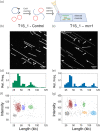Identification and characterization of plasmids carrying the mobile colistin resistance gene mcr-1 using optical DNA mapping
- PMID: 36743530
- PMCID: PMC9891347
- DOI: 10.1093/jacamr/dlad004
Identification and characterization of plasmids carrying the mobile colistin resistance gene mcr-1 using optical DNA mapping
Abstract
Objectives: Colistin is a last-resort antibiotic, but there has been a rapid increase in colistin resistance, threatening its use in the treatment of infections with carbapenem-resistant Enterobacterales (CRE). Plasmid-mediated colistin resistance, in particular the mcr-1 gene, has been identified and WGS is the go-to method in identifying plasmids carrying mcr-1 genes. The goal of this study is to demonstrate the use of optical DNA mapping (ODM), a fast, efficient and amplification-free technique, to characterize plasmids carrying mcr-1.
Methods: ODM is a single-molecule technique, which we have demonstrated can be used for identifying plasmids harbouring antibiotic resistance genes. We here applied the technique to plasmids isolated from 12 clinical Enterobacterales isolates from patients at a major hospital in Thailand and verified our results using Nanopore long-read sequencing.
Results: We successfully identified plasmids encoding the mcr-1 gene and, for the first time, demonstrated the ability of ODM to identify resistance gene sites in small (∼30 kb) plasmids. We further identified bla CTX-M genes in different plasmids than the ones encoding mcr-1 in three of the isolates studied. Finally, we propose a cut-and-stretch assay, based on similar principles, but performed using surface-functionalized cover slips for DNA immobilization and an inexpensive microscope with basic functionalities, to identify the mcr-1 gene in a plasmid sample.
Conclusions: Both ODM and the cut-and-stretch assay developed could be very useful in identifying plasmids encoding antibiotic resistance in hospitals and healthcare facilities. The cut-and-stretch assay is particularly useful in low- and middle-income countries, where existing techniques are limited.
© The Author(s) 2023. Published by Oxford University Press on behalf of British Society for Antimicrobial Chemotherapy.
Figures






Similar articles
-
Detection of Five mcr-9-Carrying Enterobacterales Isolates in Four Czech Hospitals.mSphere. 2020 Dec 9;5(6):e01008-20. doi: 10.1128/mSphere.01008-20. mSphere. 2020. PMID: 33298573 Free PMC article.
-
Silent spread of mobile colistin resistance gene mcr-9.1 on IncHI2 'superplasmids' in clinical carbapenem-resistant Enterobacterales.Clin Microbiol Infect. 2021 Dec;27(12):1856.e7-1856.e13. doi: 10.1016/j.cmi.2021.04.020. Epub 2021 Apr 26. Clin Microbiol Infect. 2021. PMID: 33915285
-
Investigation of Plasmid-Mediated Colistin Resistance Genes (mcr-1-8) in Enterobacterales Isolates.Cureus. 2024 Jun 2;16(6):e61538. doi: 10.7759/cureus.61538. eCollection 2024 Jun. Cureus. 2024. PMID: 38957246 Free PMC article.
-
Genomic analysis of carbapenem- and colistin-resistant Klebsiella pneumoniae complex harbouring mcr-8 and mcr-9 from individuals in Thailand.Sci Rep. 2024 Jul 22;14(1):16836. doi: 10.1038/s41598-024-67838-5. Sci Rep. 2024. PMID: 39039157 Free PMC article.
-
How to: screening for mcr-mediated resistance to colistin.Clin Microbiol Infect. 2022 Jan;28(1):43-50. doi: 10.1016/j.cmi.2021.09.009. Epub 2021 Sep 16. Clin Microbiol Infect. 2022. PMID: 34537365 Review.
Cited by
-
The Emergence of Nanofluidics for Single-Biomolecule Manipulation and Sensing.Anal Chem. 2025 Apr 29;97(16):8641-8653. doi: 10.1021/acs.analchem.4c06684. Epub 2025 Apr 17. Anal Chem. 2025. PMID: 40244645 Free PMC article. Review.
-
A trackable trinuclear platinum complex for breast cancer treatment.Nucleic Acids Res. 2025 Jul 8;53(13):gkaf628. doi: 10.1093/nar/gkaf628. Nucleic Acids Res. 2025. PMID: 40671528 Free PMC article.
References
LinkOut - more resources
Full Text Sources
